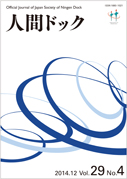Volume 29, Issue 4
Displaying 1-11 of 11 articles from this issue
- |<
- <
- 1
- >
- >|
Foreword
-
2014 Volume 29 Issue 4 Pages 561
Published: 2014
Released on J-STAGE: March 30, 2015
Download PDF (281K)
Review
-
2014 Volume 29 Issue 4 Pages 562-570
Published: 2014
Released on J-STAGE: March 30, 2015
Download PDF (1354K)
Original Articles
-
2014 Volume 29 Issue 4 Pages 571-576
Published: 2014
Released on J-STAGE: March 30, 2015
Download PDF (897K) -
2014 Volume 29 Issue 4 Pages 577-584
Published: 2014
Released on J-STAGE: March 30, 2015
Download PDF (1381K) -
2014 Volume 29 Issue 4 Pages 585-591
Published: 2014
Released on J-STAGE: March 30, 2015
Download PDF (1050K) -
2014 Volume 29 Issue 4 Pages 592-600
Published: 2014
Released on J-STAGE: March 30, 2015
Download PDF (2790K) -
2014 Volume 29 Issue 4 Pages 601-609
Published: 2014
Released on J-STAGE: March 30, 2015
Download PDF (1008K) -
2014 Volume 29 Issue 4 Pages 610-615
Published: 2014
Released on J-STAGE: March 30, 2015
Download PDF (847K)
Short Report
-
2014 Volume 29 Issue 4 Pages 616-622
Published: 2014
Released on J-STAGE: March 30, 2015
Download PDF (1396K)
Report
-
2014 Volume 29 Issue 4 Pages 623-635
Published: 2014
Released on J-STAGE: March 30, 2015
Download PDF (2224K)
Report
-
2014 Volume 29 Issue 4 Pages 636-638
Published: 2014
Released on J-STAGE: March 30, 2015
Download PDF (514K)
- |<
- <
- 1
- >
- >|
